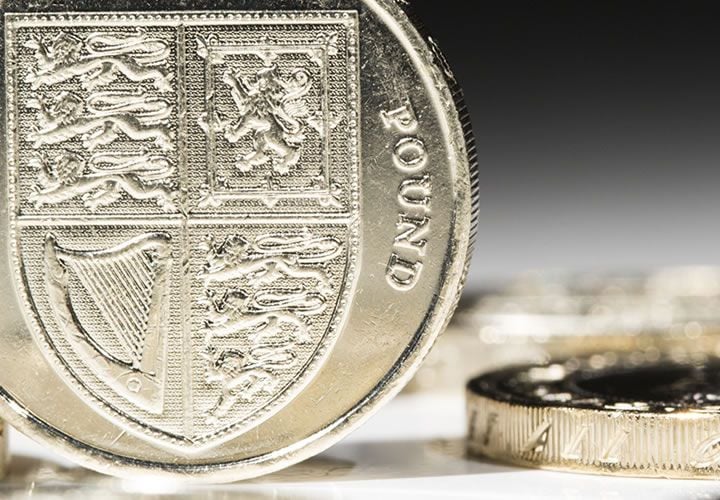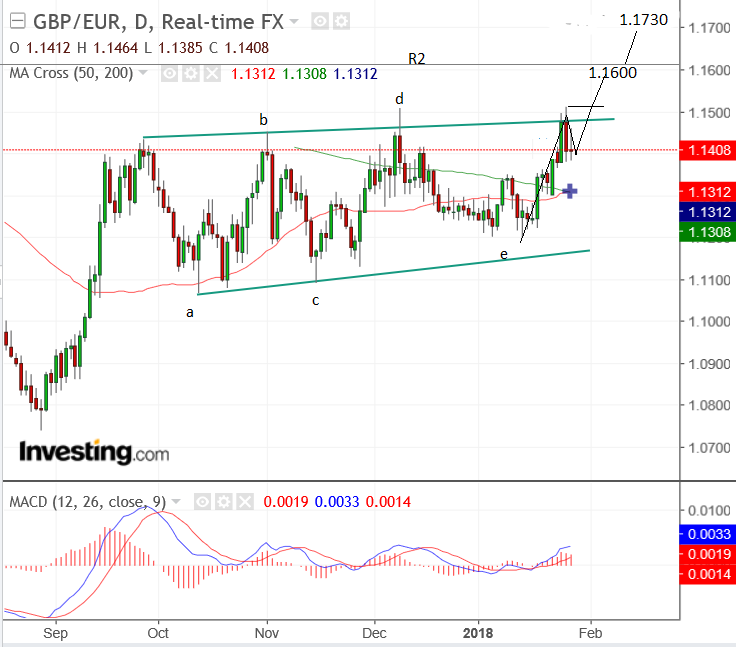Pound-to-Euro Exchange Rate's Forecast for the Week Ahead

Despite a strong bounce last week, Pound Sterling is still ultimately caught in sideways trading pattern against the Euro, but we forecast an eventual breakout higher.
The Pound-to-Euro exchange rate has suffered a sharp decline at the start of the new trading line confirming that the time to break out higher from its multi-week range has not yet come.
Indeed, the decline back down to current prices at 1.1357 are consistent with the view that the failure to break the top of the ceiling must see the exchange rate dip back into the range.
The most recent attempted breakout saw the pair peak at 1.1513 - a new high for the year. We note that just as Sterling was about to break higher the European Central Bank's January policy meeting rejuvenated demand for Euros and Sterling fell back into its medium term range that is broadly defined by the 1.11 level at the bottom, and 1.1510 at the top.
The move confirms the gravitational pull of this area and suggests a major positive must be delivered for either the Euro or Pound (or negative!) for it to break the range.
Yet, at the current juncture we still see an upside breakout as more likely but would require a break above the new 1.1513 highs for confirmation. Importantly, the exchange rate must close the day above this point.
The current pull-back which has brought the pair down to 1.1408 is probably only temporary and we expect the uptrend to resume fairly soon.
Note how all the other component legs in the range (a-e) are composed of at least three distinct waves in a zig-zag motif - the same cannot be said of the most recent move higher, suggesting it still has a third wave up which has yet to evolve.
Ultimately we still expect a move above the 1.1513 highs to confirm a breakout and then a rally up to the next target at 1.1600, just below the R2 monthly pivot.
Monthly Pivots are barriers to further upside as they attract a lot of selling interest from short-term technical traders looking to counter-trend the rally.
A break above R2, confirmed by a move above 1.1630 would confirm a continuation up to the next target at 1.1730.
Get up to 5% more foreign exchange by using a specialist provider to get closer to the real market rate and avoid the gaping spreads charged by your bank when providing currency. Learn more here.
Data and Events to Watch for the Pound
The main data release in the week ahead for the Pound is survey data for Manufacturing and Construction in January, in the form of Markit IHS's purchasing manager indices (PMIs).
These are normally a reliable forward indicator of activity and trends within the broader economy and economists use them to predict growth. Markets will be looking for confirmation that the better-than-forecast economic momentum enjoyed by the UK economy in the final quarter of 2017, confirmed in last week's GDP data, has extended into the new year.
Manufacturing PMI is out at 9.30 GMT on Thursday, February 1 and is expected to rise to 56.5 from 56.3 previously.
Global investment bank TD Securities say economists are being too optimistic about Manufacturing and the index will fall to 55.9 instead of rising to 56.5; an outcome that would certainly weigh on the Pound we believe.
"We’re looking for a modest pullback in the manufacturing PMI after last month’s larger nearly 2pt decline, with the index falling from 56.3 to 55.9 in January. We expect to see some of the weakness in the flash Eurozone print reflected in the UK outcome," say TD Securities in a briefing to clients ahead of the new week.
Construction PMI is out at the same time on the following day and is forecast to fall to 52.0 from 52.2 in December. Note that the sector is in recession, according to official GDP data, so some recovery will be keenly anticipated. However, construction is a small component of the UK economy and the impact on Sterling will likely be small, if any. Nevertheless, clues on longer-term prospects for the economy will be key for overall sentiment.
One further event of interest to Pound-watchers in the week ahead is Bank of England (BOE) governor Mark Carney's testimony to the Lord's Economic Affairs Committee at which he will have the opportunity to comment on the state of the economy and monetary policy before the 'black-out' period prior to the next official BoE rate meeting.
Markets are keen to ascertain whether or not the Bank of England will raise interest rates in 2018, in a follow up to 2017's rate rise. Markets are anticipating this is the case, but a bullish assessment by Carney could certainly be the catalyst to a higher Sterling in the coming week we believe.
Carney's appearance in Davos last week was striking in that he hinted that he is taking a more optimistic stance on the UK economy, seeing growth picking up sharply towards the end of the year as the UK "consciously recouples" with the accelerating global economy.
He will certainly be queried on this, and the answers will be closely followed by currency traders.
Data and Events for the Euro
Eurozone inflation is probably the most important release for the Euro in the week ahead. The market currently expects it to moderate to 1.3% year-on-year (yoy) from 1.4% yoy in December so a drop may not impact on the Euro as much as might be expected.
The outcome is important in the context of how the European Central Bank approaches its policy settings going forward - if inflation is seen accelerating then there is a chance that they will soon indicate they are to end their extraordinary monetary stimulus programme.
Markets are currently betting that this is indeed likely to occur in coming months, hence we saw the Euro rally following the outcome of the ECB's January policy meeting update.
Stronger inflation will reaffirm this trend. "EUR has been strong this year as the market looks forward to the ECB ending its asset purchase programme. While the CPI data could have a short term impact on EUR on any surprise, we think the ECB is keen to end its emergency policy settings regardless," says Jason Wong at BNZ.
Analysts at TD Securities however warn the market is being too optimistic and inflation will probably show a fall to 1.1% because of the drag owing to, "base effects after large gains in food and energy prices in Jan 2017."
This could certainly weigh on the Euro.
Like the market, however, they see Core Inflation - which does not include food and fuel - rising to 1.0% but also languishing at that rather low level for the remainder of the first half of the year.
The release for both is out at 10.00 GMT on Wednesday, January 31.
Tuesday, January 30 sees the release of Q4 GDP for the Eurozone - also at 10.00 - which is expected to show a rise of 2.6% yoy and 0.6% quarter-on-quarter - the same as in Q3 - a stronger-than-expected print would probably give the Euro another boost and vice versa for a weaker.
"Preliminary estimates of euro area fourth-quarter GDP figures are eagerly awaited by analysts and are widely expected to be strong given the recent flow of positive data. IHS Markit PMI data signaled an impressive 0.8% expansion in the final three months of 2017, higher than the 0.6% in the third quarte," says IHS Markit in a briefing on the events to watch in the coming week.
Unemployment data, out at the same time is forecast to remain at 8.7% in December. Both GDP and employment data are unlikely to impact the single-currency to the extent that inflation would.
However, another big release to watch is the Eurozone Manufacturing PMI, out at 9.00 on Thursday, Feb 1, which is forecast to stay unchanged at 59.6 in January.
The data should confirm that the Eurozone economy is expanding at a blistering pace, as per the prelimary estimate released last week, and is therefore providing a fundamental unerpinning to the Euro's long-term rise.
However, the surprise-factor of a final estimate is never as great as the preliminary release, so expect a muted Euro reaction.
Get up to 5% more foreign exchange by using a specialist provider to get closer to the real market rate and avoid the gaping spreads charged by your bank when providing currency. Learn more here.





